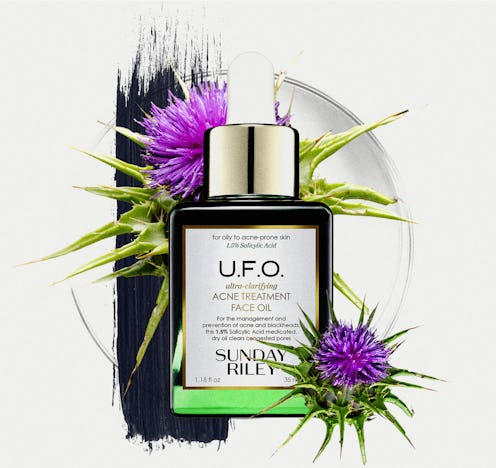(Back To Basics)
If You Have Oily, Acne-Prone Skin, This Herb Should Be On Your Radar
How milk thistle and its derivatives can help de-slick your complexion.

With new products, brands, and categories popping up every day, beauty can be a bit overwhelming. Back to Basics is our rudimentary beauty series that serves as your crash course on the science behind some of the best formulations in the game.
If you're dealing with oily or acne-prone skin, then you're likely already well-versed in the skin care heavy-hitters that are most beneficial for your skin type. There’s retinol and prescription retinoids for fighting persistent breakouts and salicylic acid for declogging pores and tamping down oiliness. However, when it comes to upping your skin’s defense against free radicals and stopping greasiness in its tracks, milk thistle is the latest under-the-radar skin care ingredient you need to know.
Also known as silybum marianum, milk thistle has been used in plant medicine for centuries, lauded as a remedy for everything from preventing various liver diseases to promoting lactation and curing hangovers. As it turns out, the seed extract of this flowering herb — known for its spiny purple and red flowers — has a number of complexion-perfecting properties when slathered onto the skin. And although it might be less well known than some skin care heavy hitters like say, hyaluronic acid, the experts predict that the range of benefits and efficacy of milk thistle will make it a cult-classic in no time.
What Is Milk Thistle?
As a topical skin care ingredient, milk thistle boasts several benefits. However, it's important to understand that these benefits should be credited to silymarin, a flavonoid found in milk thistle seeds that, according to cosmetic chemist and director of research and development for SOS Beauty Nick Dindio, "contains all the good stuff" — namely a mixture of pharmacologically active components that are insoluble in water, he explains. While most topical milk thistle products contain milk thistle as is, a few out there are solely formulated with silymarin extract — and, in turn, are typically more potent.
First and foremost, silymarin (and, therefore, milk thistle) is a powerful antioxidant — in fact, cosmetic dermatologist Dr. Mariana Vergara points out that it's been shown to be even more potent than vitamin E. "It protects the skin from free radicals and pollutants," she says. "When used topically, it can protect against UVA and UVB damage. It's also been shown to have anti-aging properties, as it's known to inhibit the process of glycation, which can prevent skin aging."
As an antioxidant, board-certified dermatologist Dr. Corey L. Hartman says that it also protects against collagen and elastin breakdown and improves circulation in the skin at a cellular level. But the benefits don't stop there: Silymarin also packs a powerful anti-inflammatory punch. "It can help calm irritated skin conditions and promote homeostasis through regulation of free radicals," he says.
What makes silymarin stand out amongst the other topical antioxidants available today is its anti-inflammatory properties that help calm breakouts and its ability to control oil production, both crucial if you’re struggling with acne breakouts. "It has a direct impact on the activity of the oil glands and their ability to drive sebum production," explains Dr. Hartman. Dr. Vergara points out another plus: "It's also non-comedogenic, so it won't clog your pores, which is a factor that leads to breakouts in patients with acne."
How To Use Milk Thistle
How you use topical milk thistle will depend on the type of product it's formulated into, but in general, Dindio recommends using it twice daily. "[Milk thistle] primarily affects conditions that accumulate throughout the day, so I would recommend using it in the morning and in the evening for maximum effects," he says. "Applying the product in the morning would help to mitigate damage acquired throughout the day while applying in the evening would ensure that you are addressing any additional damage." Serums generally are more potent, but the experts don’t say that using one is necessarily better than a mask or moisturizer — use whatever works best for your skin.
Because silymarin, the primary flavonoid in milk thistle, contains large molecules that don't easily penetrate the skin, Dindio also says it's best to look for formulas that incorporate encapsulation or other methods that increase its bioavailability. Some products will list milk thistle on the label while others isolate the silymarin flavonoid, but you will get the same benefits for both.
In terms of incorporating into your existing routine, milk thistle is compatible with most other ingredients, though Dr. Hartman says they pair especially well with other antioxidants like vitamin C and ferulic acid, as well as salicylic acid.
Who Is A Good Candidate For Milk Thistle?
In general, milk thistle plays nicely with all skin types and tones. Because it provides antioxidant protection, Dindio considers it a prime candidate for anyone looking to prevent or improve the appearance of photoaging and the effects of environmental stressors (like dullness, fine lines, and more). But due to its anti-inflammatory and oil-controlling properties, Dr. Hartman says its a particularly great choice for anyone with oily or acne-prone skin. Overall, he considers milk thistle to be a great way to reap multiple skin benefits at once: "[Milk thistle is] easily incorporated into a skin care regimen and achieve more than one goal, which is always a consideration for me, a skin care minimalist."
Ahead, seven milk thistle and silymarin products to incorporate into your routine to up your skin's free radical defense, fight signs of aging, and tackle oiliness and breakouts.
We only include products that have been independently selected by TZR's editorial team. However, we may receive a portion of sales if you purchase a product through a link in this article.
This article was originally published on